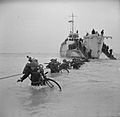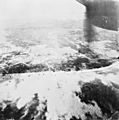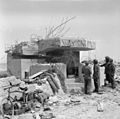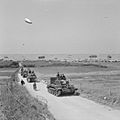Gold Beach facts for kids
Quick facts for kids Gold Beach |
|||||||
|---|---|---|---|---|---|---|---|
| Part of the Normandy landings | |||||||
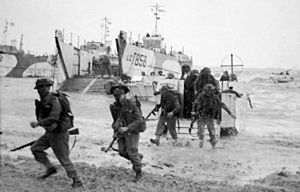 Men of No. 47 Commando landing on Gold near La Rivière |
|||||||
|
|||||||
| Belligerents | |||||||
|
|||||||
| Commanders and leaders | |||||||
| Units involved | |||||||
|
|
||||||
| Casualties and losses | |||||||
| 1,000–1,100 (350 killed) | Unknown | ||||||
Gold Beach was the secret code name for one of the five main landing spots during the Normandy landings on June 6, 1944. This huge invasion happened during World War II when the Allied forces attacked German-controlled France. Gold Beach was right in the middle of these five landing areas. It stretched between Port-en-Bessin on the west and La Rivière on the east.
Because of tall cliffs at one end, the actual landings happened on a flatter part of the beach. This area was between Le Hamel and La Rivière. The specific sections were called Jig and King. The British Army was in charge of taking Gold Beach. The Royal Navy, along with ships from the Dutch and Polish navies, helped by transporting troops, clearing mines, and firing at German defenses.
Contents
Goals for Gold Beach
The main goals for the soldiers landing at Gold Beach were very important. They needed to create a safe area on the coast, called a beachhead. From there, they would move west to capture the town of Arromanches. They also had to connect with the American forces who were landing at Omaha Beach.
Another key goal was to capture the city of Bayeux and a small port at Port-en-Bessin. Finally, they had to link up with the Canadian forces who were landing at Juno Beach to the east. The German forces defending Gold Beach included parts of the German 352nd Infantry Division and the German 716th Infantry Division. About 2,000 German soldiers were in the immediate area. Germany had been improving its coastal defenses since October 1943, led by Generalfeldmarschall Erwin Rommel.
D-Day Landings at Gold Beach
On D-Day, the naval bombardment began at 5:30 AM, with warships firing at German positions. The first landing boats reached the shore at 7:25 AM. Strong winds made it hard for the landing craft. Special amphibious tanks, called DD tanks, were supposed to be launched far from shore. But because of the rough seas, they had to be released closer to the beach or directly on it.
Attacking German Defenses
Three of the four large guns at the Longues-sur-Mer battery were destroyed by direct hits from British cruisers at 6:20 AM. The fourth gun kept firing sometimes in the afternoon. Its soldiers surrendered the next day, June 7. Air attacks had failed to hit a strong German position at Le Hamel. This position had a gun opening facing east, allowing it to fire along the beach. It also had a very thick concrete wall facing the sea. Its 75mm gun kept firing until 4:00 PM. Then, a special tank called an Armoured Vehicle Royal Engineers (AVRE) fired a huge bomb into its back entrance, finally stopping it. Another strong concrete bunker at La Rivière, which held an 88mm gun, was also knocked out by a tank at 7:30 AM.
Pushing Inland
While the tanks dealt with the strongpoints, the infantry soldiers began clearing out the heavily fortified houses along the shore. They then moved towards their targets further inland. The British Commandos from No. 47 (Royal Marine) Commando advanced towards Port-en-Bessin. They successfully captured it on June 7, after a fierce fight known as the Battle of Port-en-Bessin.
On the western side, the 1st Battalion of the Royal Hampshire Regiment captured Arromanches. This town later became the site of one of the artificial Mulberry harbours, which were temporary ports built to bring in supplies. On the eastern side, the 69th Infantry Brigade met up with the Canadian forces who had landed at Juno Beach.
Heroic Actions
Company Sergeant Major Stanley Hollis showed incredible bravery. He was awarded the only Victoria Cross given on D-Day for his actions. He attacked two German bunkers at the Mont Fleury battery by himself. Because of strong resistance from the German 352nd Infantry Division, the city of Bayeux was not captured until the next day. The British forces at Gold Beach had about 1,000 to 1,100 casualties, with 350 soldiers killed. The number of German casualties is not known.
Images for kids
-
Operations in the Battle for Caen
See also
 In Spanish: Playa de Gold para niños
In Spanish: Playa de Gold para niños



